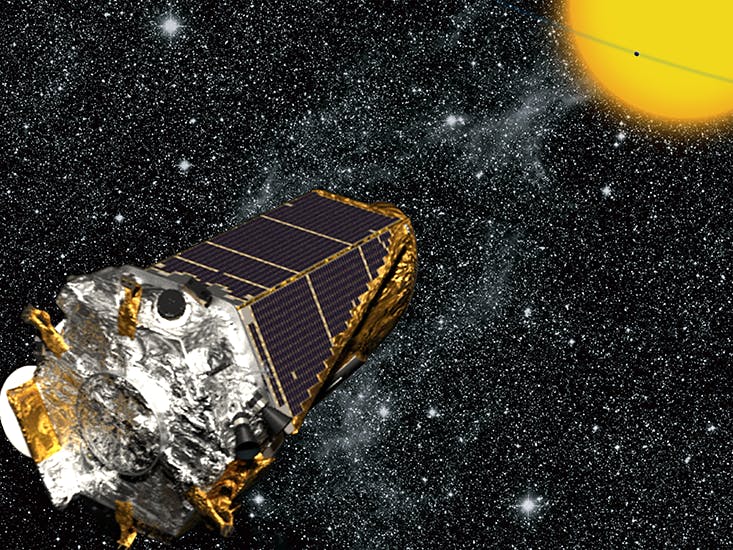The Kepler spacecraft had a pretty good run. Launched in 2009, it soon settled into its intended orbit around the Sun, trained its image sensors up at a patch of sky about as big as your fist held at arm’s length, and began watching, which it’s been doing ever since. Kepler’s job is to find exoplanets that cross, or “transit,” in front of the stars that they orbit. It’s a very tough job: The stars are far away and very bright, while the planets are entirely dark, and the most Earth-like ones are relatively tiny. “The technique is equivalent to spotting a flea on a light bulb 3,000 miles away, roughly the distance from Los Angeles to New York City,” in the words of one astronomer.
Kepler measured up to the challenge, discovering 132 planets whose existence was corroborated by other telescopes and over 3,200 more “candidates” that have yet to be corroborated, but are likely to be real. In short, Kepler confirmed the long-held belief of astronomers that there are billions of planets out there, some of them similar to ours, at least in broad strokes. (See Lee Billings’ earlier posts about what an “Earth-like” planet really is.) Kepler is scheduled to keep spotting planets for another three years, during which time it’s supposed to home in ever closer on small, rocky planets like ours. But it may never get the chance.
In 2012, one of Kepler’s “reaction wheels”—a kind of flywheel that helps keep the telescope pointed in the right direction—failed. That left the craft with three reaction wheels, just enough to keep going. But last month, another wheel broke down, leaving the telescope unable to point accurately, which would probably render it unable to fulfill its promise of finding a bounty of Earth-like planets. NASA will try to resurrect the broken reaction wheels, but it seems unlikely to work. “The science we were doing with Kepler, as we were doing it, is over,” said one of the engineers who built Kepler. “It’s very unlikely that it can be restored to any kind of usefulness.” And the craft, in its distant heliocentric orbit, is much too far for an astronaut to fix, a la Hubble. (Since the retirement of the Space Shuttle, NASA doesn’t even have a spaceship to send an astronaut anywhere, let alone much farther out into space than ever before. And even getting to low Earth orbit and back was dicey with the Shuttle.) So that’s it. Game over, man.
Or so it seemed last month. But last week two astronomers floated the idea that Kepler could be harnessed for a different use: spotting exoplanets through “gravitational microlensing,” the way a massive object bends beams of light that pass by it. Jacob Aron describes how this approach would work in New Scientist:
When two stars align in our line of sight, the gravitational pull of the closer star bends and magnifies the light of the further star. If the nearer star has orbiting planets, their gravity provides added magnification. “The signals from planets are quite large in this case, sometimes even a 100 per cent change of brightness of the star, so it’s relatively easy to see these things,” says [one author of the new study].
This idea for creatively repurposing Kepler might be a gift falling into the lap of planet-hunters, or it may not ever work out. In any case, we shoudn’t be too surprised that the idea is emerging. The human imagination has an unparalleled ability to explore the “adjacent possible,” a term coined by theoretical biologist Stuart Kauffman and explained well by writer Steven Johnson:
The adjacent possible is a kind of shadow future, hovering on the edges of the present state of things, a map of all the ways in which the present can reinvent itself.
The strange and beautiful truth about the adjacent possible is that its boundaries grow as you explore them. Each new combination opens up the possibility of other new combinations. Think of it as a house that magically expands with each door you open. You begin in a room with four doors, each leading to a new room that you haven’t visited yet. Once you open one of those doors and stroll into that room, three new doors appear, each leading to a brand-new room that you couldn’t have reached from your original starting point. Keep opening new doors and eventually you’ll have built a palace.
Wherever there’s a group of humans, they’re always dreaming of how to push the limits, how to open those doors and keep exploring new rooms. This is, to a great extent, why the long-term future of humanity is so full of uncertainty. Dig up some black liquid in the ground, and we’ll figure out how to power a planet. Come across a halo around a blob of mold in a petri dish, and we’ll turn it into the most powerful medicine in the world. Show us a tiny electronic switch, and we’ll give you an iPad with wifi and cellular and a Retina display, in black or white.
Give us one slightly damaged but still usable super-high-tech orbital telescope, and I’d only expect some creative ideas for how to use it to make amazing discoveries.
Amos Zeeberg is the digital editor of Nautilus and oversees Facts So Romantic. Find him on Twitter @settostun.



